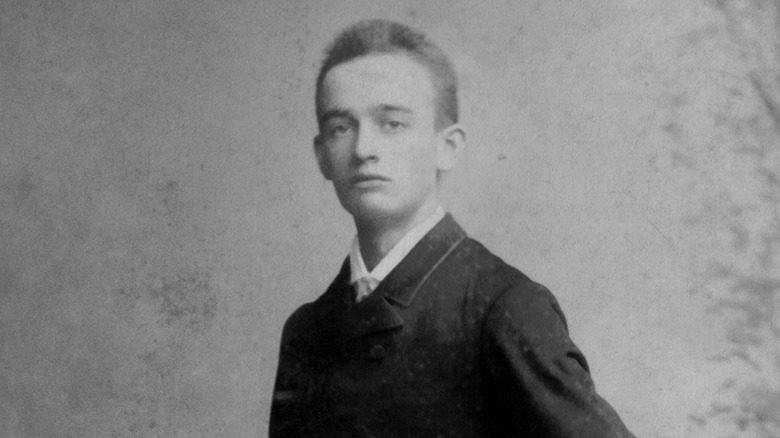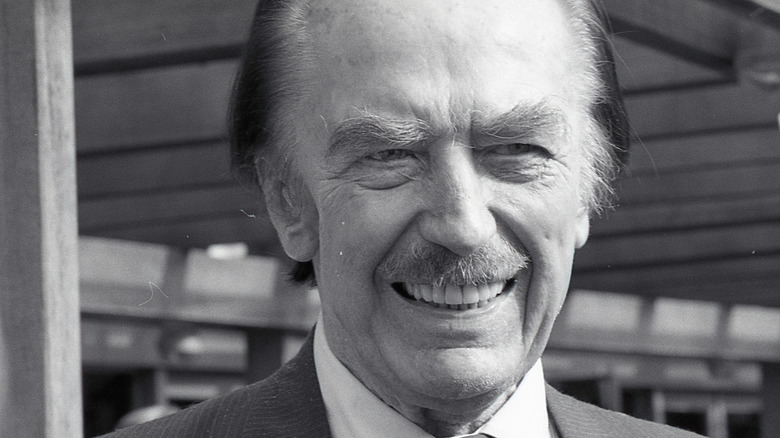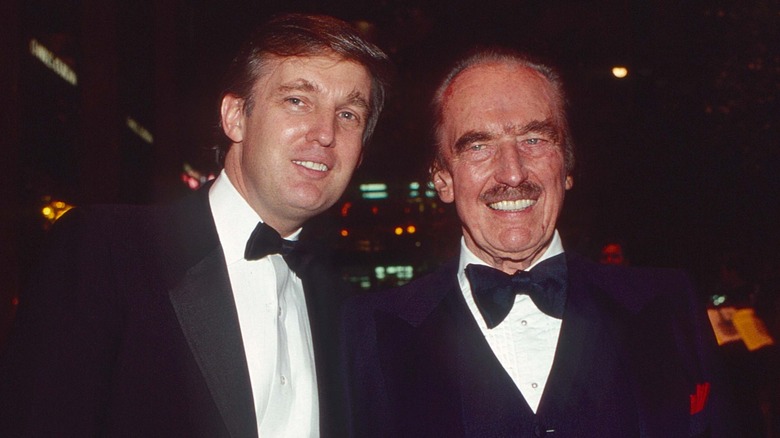The Rise And Fall Of The Trump Family's Reign Of New York
We may receive a commission on purchases made from links.
The Trump family name, over time, has gone from being synonymous with glitzy buildings to being synonymous with American politics. In 2016, Donald Trump, the most famous member of the clan, won the United States' presidential election, marking the Trumps' entry into the U.S. political scene.
But long before their foray into Washington D.C., the Trump family had established themselves in New York City with a vast real-estate empire operating under the Trump Organization. The organization, headquartered in NYC, controls hundreds of successful businesses spanning hotels, golf courses, residential properties, and even television. Additionally, a good majority of members of the Trump family were born and raised in New York.
Yet, despite these longstanding ties, the Trumps' relationship with their hometown has soured over the years. "He is persona non grata in New York City," former governor Andrew Cuomo told The New York Times, of Donald's popularity over the years. From their early beginnings to the slow decline of their celebrity, here's a look into the rise and complicated fall of the Trump dynasty in the Big Apple.
Friedrich Trump set the foundation for the family's real estate in New York
The Trump family's history in New York dates back to 1885, when Friedrich Trump, a German immigrant, arrived in Manhattan, searching for better opportunities. At the time, Friedrich had nothing but his lofty dreams. "He didn't know English," Trump biographer Gwenda Blair told The Washington Post of Friedrich, highlighting his humble beginnings in America. "He didn't have anything like a high school diploma. He was literate, but in German." Within the next two decades of his arrival, Friedrich lived in multiple cities, trying his hands at different businesses and amassing a decent amount of wealth.
Despite his exploits in America, Friedrich tried to remember his roots, visiting Germany when he could. It was during one of these visits to Germany, that Friedrich met Elizabeth Christ. The couple got married in 1902, returned to New York, and soon started their family. Two years after getting married, Friedrich and Elizabeth welcomed their first child, daughter Elizabeth, closely followed by their son, Fred, born in 1905, and another son, John, in 1907.
Friedrich soon laid the foundation for the Trumps' real estate empire when, in 1908, he purchased a property on Jamaica Avenue in Queens and put a section of it up for rentals. Sadly, Friedrich's hope of living out the American dream never came to fruition, as he died of influenza in 1918 at just 49 years old.
Elizabeth Trump and son Fred continued Friedrich's legacy in NYC
After Friedrich Trump's death, his wife, Elizabeth Christ Trump, took over the family's budding real estate business, managing the small portfolio of properties, which were valued at over $31,000. Though she initially ran the business under the name "E. Trump," Elizabeth eventually changed it to "E. Trump & Son" after it became clear that the couple's second child, Fred, would be joining her to carry on Friedrich's legacy. "I always wanted to be a builder — it was my dream as a boy, just as some kids want to be firemen or cops or chemists," Fred later gushed in a 1973 interview with The New York Times.
While he was too young to get involved in the family's business at the time of his father's death, Fred later began his real estate career as a teenager, starting off with a simple neighborhood garage project. "Probably not the greatest garage ever put up, but the experience reinforced my hope of doing something creative with wood and bricks and cement," he explained in his New York Times interview. After finishing high school, Fred built his first home with an $800 loan from his mother, reportedly selling it for $7,000. In the years to come, Fred built even more homes, recording impressive profits and setting himself up for the long journey ahead.
Fred Trump dominated New York's real estate scene for several decades
After recording mostly successes with his earliest building, Fred Trump was inspired to do even more. In the following decades, Fred dominated New York's real-estate scene, racking up monumental projects like the highly successful Trump Market and springing up hundreds of buildings targeted at providing housing for low-income earners in the Manhattan community.
This business expansion was further made possible by subsidized loans provided by the Federal Housing Administration during and after the Great Depression. Fred also utilized these loans to cater to the needs of veterans who needed housing after the war, resulting in the Shore Haven and Beach Haven Apartments in Brooklyn, New York. According to Gwenda Blair's "The Trumps: Three Generations That Built an Empire," it was during this period when Fred reached the multi-millionaire mark, cementing his status as a prominent figure in New York's real estate history.
"He built what everybody's talking about today as the impossible market," Julia Vitullo-Martin, a former fellow at New York's Regional Plan Association, told the Washington Post of Fred's determination to make as much profit as possible with affordable housing. In addition to Shore Haven and Beach Haven Apartments, Fred is also famous for developing Trump Village, which remains one of his most popular projects to date.
Fred Trump was investigated multiple times in the '50s and '60s
In 1954, Fred Trump found himself under federal scrutiny after accusations emerged that he falsified figures to profit from government-issued building projects. The United States Senate Banking Committee subsequently carried out an investigation, accusing Trump and his business partner, William Tomasello, of inflating the cost of their Beach Haven Apartments project by approximately $3.5 million.
During his testimony, Fred admitted to spending less than the obtained loan but argued against any wrongdoing simply because he had not withdrawn the excess money. "I have never drawn a salary the three years that Beach Haven has been operating," he declared to the committee. As a result of the allegations, Fred was banned from securing future federal loans for his building projects.
Over a decade later, Fred faced new legal troubles after the New York state government looked into allegations that he had inflated and profited off state loans and used the excesses for personal projects. Among the charges levied against Fred was a $21,000 lease price for a truck that cost only $3,600 and an $8,280 bill for tile scrapers that cost only a fraction. All of these disturbing allegations birthed questions about the legitimacy of Fred's success. But none of these seemed to matter as much once his son, Donald Trump, took over the business.
Donald Trump's glitzy buildings drew a lot of criticism
After graduating from The Wharton School at the University of Pennsylvania, Donald Trump joined his father's company, quickly learning the ropes of the real estate business. By 1971, Donald had become president of the company, marking the beginning of the Trump family dynasty's crossover from affordable housing to giant glitzy, buildings.
This shift, critics argue, prioritized the ostentatious display of wealth over what was most important — architectural integrity. "To me, these buildings don't quite register as architecture," critic Herbert Muschamp wrote in The New York Times in 1999. "They look to me like signs of money, status, power."
One of Donald's most notable ventures, his Trump Tower — which the Trump Organization acquired in 1979 — penthouse, has also received its fair share of criticism. The gilded Versailles-inspired apartment and the 58-story Tower convincingly portrayed Donald's extravagant tastes to all of New York City. So, while Donald's reputation as a real estate mogul grew, so did perceptions of him as a man with an insatiable "desire for attention, for the best, the most, the tallest, the most eye-catching," as Muschamp put it.
Donald Trump expanded his family's empire in New York real estate and beyond
Settling into the business, Donald Trump focused on expanding the Trump dynasty in New York City, moving away from his father's presence in Brooklyn to focus on Manhattan. In 1978, he embarked on one of his first major project, teaming up with Hyatt Corporation to renovate the then-struggling Commodore Hotel. Transformed to fit modern demands, the establishment reopened to the public in 1980, this time with a new name — the Grand Hyatt Hotel. However, after 17 years, Donald's partnership with the Hyatt came to an end in 1996 when he sold his stake in the hotel for $140 million.
With the Grand Hyatt under his belt, Donald continued making more high-profile acquisitions, notably buying the historic Plaza Hotel for over $400 million in 1988, with the hopes of turning it around. Despite his big dreams, however, the Plaza Hotel struggled to stay financially afloat, eventually filing for bankruptcy in 1992. "To me, the Plaza was like a great painting ... I have many assets like that and the result is that they are always much more valuable than what you paid for them," Donald would later tell The New York Times of his sentiments towards the hotel.
Beyond his hospitality projects, Donald, a longtime golf enthusiast, also diversified his real estate portfolio to include golf courses across the globe. Since 1999, Donald has acquired 12 golf courses in the United States, and four more abroad in Scotland, Ireland, and the United Arab Emirates.
Donald Trump's businesses declared bankruptcy multiple times
Despite his many successes as a businessman and real estate guru, Donald Trump has faced his had share of failures. In 1990, he launched the Trump Taj Mahal, a gambling resort in Atlantic City, New Jersey, which he predicted would become one of the world's most monumental destinations. "It's truly going to be an incredible place. We're calling it the eighth wonder of the world," he told reporters at the time, per The New York Times. A year later, the casino filed for Chapter 11 bankruptcy protection, having accrued hundreds of millions of dollars in debt.
The following year, in 1992, Donald filed for bankruptcy protection for three of his other businesses – Trump Castle, Trump Plaza and Casino, as well as the Plaza Hotel — having failed to settle their debt payments. 12 years later, in 2004, he suffered another setback, forcing him to file bankruptcy for Trump Hotels and Casino Resorts, the holding company of a few of his other businesses.
Despite the financial struggle, Donald maintained a positive outlook, declaring that Trump Hotels and Casino Resorts had done well given the circumstances at the time. "I don't think it's a failure, it's a success. In this case, it was just something that worked better than other alternatives. It's really just a technical thing, but it came together," he shared in an interview with NBC News.
Trump University was an epic fail
In 2004, Donald Trump — alongside associates Michael Sexton and Jonathan Spitalny — cofounded Trump University, a New York City-headquartered (non-accredited) institution offering online and in-person real-estate courses. For Trump, the goal of the university was simple; to share knowledge with people who were looking to make it big in business and real estate. "If I had a choice of making lots of money or imparting lots of knowledge, I think I'd be as happy to impart knowledge as to make money," he declared at the time, per The Washington Post. The university, however, turned out to be a failed venture, ending operations only six years later.
In 2013, New York Attorney General Eric Schneiderman filed a $40 million fraud lawsuit against Donald and Trump University. Schneiderman accused the university of fraudulent activities after failing to deliver on its promise of teaching students how to succeed in the real estate industry. "They were convinced by very persuasive motivational speakers and videos of Trump that they were going learn how to make money in real estate. They didn't get anything," the attorney general explained in an interview with ABC News.
Former students of the school also came together, filing two additional class action suits against Donald while demanding that their money be returned. Despite initially refusing to settle, Donald agreed to a $25 million settlement for all three cases shortly after his 2016 presidential election victory.
In 2018, Donald Trump and his children were slammed with a civil lawsuit in New York
In October 2018, Donald Trump and three of his adult children, Donald Jr., Eric, and Ivanka Trump, were slammed with a class action lawsuit accusing them of violating anti-racketeering laws after falsely marketing phony business ventures to investors. In the filing, four anonymous plaintiffs accused the Trumps of accepting secret payments from three shady businesses and intentionally promoting them in a bid to deceive the unknowing investors.
Responding to the allegations, the Trumps' lawyer, Alan Garten, called the lawsuit a politically motivated move, adding that it was the opposition's attempt at getting back at the then-president. "This is clearly just another effort by opponents of the president to use the court system to advance a political agenda. Their motivations are as plain as day," Garten shared in a statement with The New York Times.
After a failed move to dismiss the case and move it to arbitration, Donald Sr., Donald Jr., Eric, and Ivanka agreed to be deposed in 2022, four years after the lawsuit was first filed. The following year, the plaintiffs dropped their case against Ivanka, Eric, and Donald Jr., leaving only their dad as a defendant. Eventually, after years of back and forth, Lorna Schofield, a U.S. district judge, dismissed the case, noting that it didn't need to be in a federal court. "Because this case now involves only three individual plaintiffs asserting claims under their respective states' laws, it is not better suited for adjudication in this court than in state court," Judge Schofield shared in her ruling, encouraging plaintiffs to refile in their state courts.
The decline of the famous Trump Tower
After Donald Trump's 2016 presidential election and move to the White House, the Trump family's popularity waned in historically-liberal New York City. So did the reputation of their iconic eponymous towers. In January 2021, TB Alliance, a non-profit organization, shared its plans to evacuate the famous Trump Tower, sharing in a statement to Forbes that it was "exploring all options for relocating outside of 40 Wall Street."
News of TB Alliance's exit plan came shortly after the Girl Scouts of Greater New York also declared its intention to move out from Trump Tower. "As a matter of very high priority, our organization has been exploring options for getting out of the lease and the building," CEO Meredith Maskara told Business Insider at the time. However, this wasn't the beginning of the Trump Tower decline.
In 2019, Bloomberg released a report, revealing that condo owners in Trump Tower were looking to sell off their properties amid the impacts of global inflation. The report highlighted the tower's slow fall from grace, with its occupancy rate dropping from 99% to 83% over a seven-year period. "If I were looking for office space, that would be a building I'd want to avoid," Edward Son, a real estate analyst, explained to the publication. But while economic factors might have contributed to the building's decline, there's no denying that Donald's presidency and his decreasing popularity played a significant role in the exodus of tenants from Trump Tower.
The Trump family's exodus from the Big Apple to Florida
Despite their long-existing ties to New York City, the Trumps have left the Empire State in droves, choosing instead to set new roots in sunny Florida. In September 2019, Donald Trump famously announced he would be changing his primary residence from Trump Tower to his famous Palm Beach resort, Mar-a-Lago.
"I cherish New York, and the people of New York, and always will, but unfortunately, despite the fact that I pay millions of dollars in city, state, and local taxes each year, I have been treated very badly by the political leaders of both the city and state. Few have been treated worse," Donald shared in a tweet. That same month, both Donald and his wife, Melania Trump, declared Mar-a-Lago as their primary residence.
The trend, however, didn't stop with Donald and his wife; the older Trump kids also quickly ditched the Big Apple for Florida. Donald Trump Jr. and his fiance, Kimberly Guilfoyle, have since taken up residence at Admirals Cove in Jupiter, where they purchased a $9.7 million mansion back in 2021. "There is no way they can stay in New York. They'd be tortured in the streets," a source close to the family told the New York Post, highlighting the family's unpopularity in their hometown. Meanwhile, Ivanka Trump and her husband, Jared Kushner, also made the move to Miami, where they have reportedly been enjoying a quiet life. "They're really just settling into normal life and really enjoying it," a friend of the couple shared with People.












